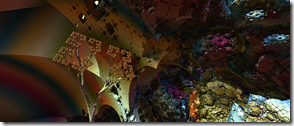I was scanning recommended videos on Youtube when I came across this one:
I had to see this. It was amazing. I was hooked. I had to find more.
That led me to this program: https://sourceforge.net/projects/mandelbulber/files/Mandelbulber%20v2/win64%20build/
Which I then ran, and tinkered with. Result: I rendered two/three desktop backgrounds for myself.
 |
 |
 |
At 2560×1080, the first two took about 15 minutes. The third one, which looks like the second one, was actually rendered at 5120×2160, and then scaled down to 2560×1080 (simulating an anti-aliasing of 2x). However, it .. came out different:
There are more holes, in the one with higher resolution.
This is because
a) Mandelbulber dynamically scales fractal complexity as it raytraces, and
b) the model that I chose, i chose one with “negative scale”, which I think means, the fractal works by taking chunks out of space rather than by adding chunks into space.
I gave up at this point. There’s an unlimited investigation that could happen, and my curiosity had been satisfied. I could make desktop wallpapers of any resolution.. but I’d need to search for something cool to take a picture of. And there’s so many variables.
I did find another VR flythrough, albeit i have no VR goggles, so someday I want to see this in stereoscopic:
Be aware there’s a lot of material editing stuff that you can do as well – which can be a bit hard if you haven’t dealt with materials (specular, texture, etc) before. Oh, and dynamic volumetric fog – lots of computation even at 320×200. Like I said, unlimited time could be spent…
Or you can oogle these:
http://www.mandelbulber.com/gallery_page1.php
(screenshotted so you can see how beautiful before deciding to click the link).




